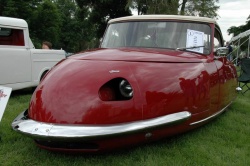 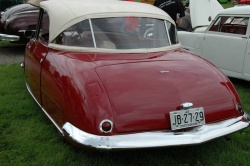 Davis Delta. Click image to enlarge |
|
Related links
|
Article and photos by Paul Williams
Photo Gallery:
2009 Orphan Car Show
Ypsilanti, Michigan – These are trying times for the automotive sector, both in North America and world-wide. Apparently Saturn will continue after all, but Pontiac is doomed. Europe’s Opel (a division of General Motors) appears saved by new Canadian/Russian ownership and Chrysler by Fiat. We’ll see.
Perhaps surprisingly, these events are nothing new for an industry that has seen countless brands come and go over the years, some of which built important vehicles that set standards for innovation, design and quality.
Which is why Ypsilanti, Michigan’s annual “Orphan Car Show” is so interesting. There, on the first weekend of June each year, unmodified examples of vehicles that are no longer made or imported (makes, rather than models) are displayed by car enthusiasts who like owning something different.
The operation of the show is a little different, too. Located at a park next to a scenic river in Ypsilanti’s historic “Depot Town,” the cars are arranged alphabetically, by marque, and participate in a scheduled parade lap during the day. The circuit begins with vehicles stopping in front of a small grandstand, where they’re introduced to an appreciative crowd comfortably perched on bleachers.
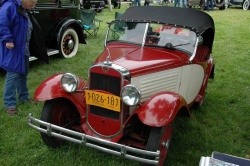 1930 American Austin. Click image to enlarge |
About 300 vehicles were present at the 2009 show, with many examples from former volume manufacturers like Hudson, Studebaker, Packard, Edsel, Nash and Rambler, and some from specialty makers like Kissel and Crosley.
Of particular interest was the 1948 Davis Delta, a three-wheeled vehicle with seating for four abreast (an idea that didn’t catch on…). This California-built car is usually seen only in museums or books, but here was Bill Miller’s Davis, one of 13 built, and in excellent condition.
Another rare car was C.E. Stephenson’s tiny, 12-horsepower, 1930 American Austin Roadster. Built under license from the British parent in Butler, Pennsylvania, the car was assembled by the American Austin Car Company, operating from 1929-1934.
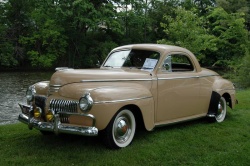 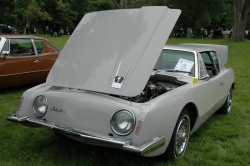 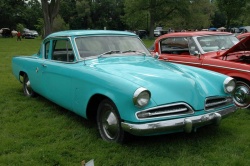 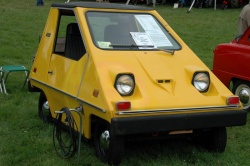 Top to bottom: 1941 DeSoto Custom Business Coupe; 1964 Studebaker Avanti; 1953 Studebaker Starlight; Sebring Vanguard Citicar. Click image to enlarge |
Joe Moss from nearby Bellevue, Michigan, brought his striking 1941 DeSoto Custom 2-Door Business Coupe, whose trunk alone would likely accommodate an American Austin. Other DeSoto models, notably Donald J. Smith’s fine 1947 Custom, looked more than ready for an extended drive along Route 66.
Design highlights at the show were Brad Daugherty’s 1953 Studebaker Starlight Coupe with its signature “wrap around” rear window, and a 1964 Studebaker Avanti, both cars a product of Raymond Loewy’s celebrated studio. The Avanti, the first production car in the U.S. with disc brakes, represented the swan-song for the venerable Studebaker company.
Design of another type (although still endearing) was demonstrated by the range of American Motors products from the 1970s and 80s. Gremlins, Pacers and Spirits were models that represented a “small” car alternative to the massive domestic cars populating North American roads in that era. But like the Avanti, these cars were actually ahead of their time; their style and functionality not appreciated by sufficient numbers of car buyers.
In fact, it’s noteworthy that several of the vehicles on display were American-built compact and sub-compact cars. Contrary to the expectation that American companies only built large vehicles, Crosley (1939-1952) sold a popular sub-compact sedan, station wagon and sports car (the Hot Shot); Nash and Hudson produced the Metropolitan; the Sebring Vanguard Citicar was a plug-in electric runabout, and the Henry J. was a “smallish” car for its day. And both Rambler and Studebaker offered several compact alternatives (the American; the Lark) to mainstream models.
Not that there weren’t big vehicles at the Ypsilanti show. Imperials from the 1950s and 1960s, DeSoto models from the ‘Forties and ‘Fifties, and a giant 1928 Graham-Paige 835 Boattail Speed were prime examples of the “full-size” American car.
The show also featured a good selection of vehicles from Kaiser, Frazer and Nash, and a full range of Chevrolet Corvairs (including an eye-catching Corvair powered “UltraVan”). All of these vehicles (except for Nash and the UltraVan) were built at nearby Willow Run factory which was purchased by Henry J. Kaiser and Joseph W. Frazer from the U.S. government in 1945.
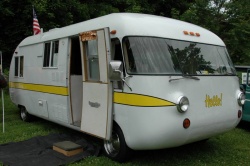 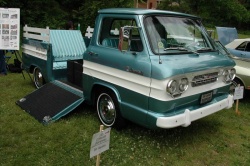 Top to bottom: Chevrolet Corvair Ultravan; 1961 Chevrolet Corvair Rampside. Click image to enlarge |
Of course, the Corvair is a model, not a make, and technically doesn’t qualify for participation in this event. But show organizers are flexible, and give the Corvair a “bye,” as many see them as “Ypsilanti’s car,” with 1,498,697 emerging from the Willow Run factory. Examples of Corvair Greenbriar minivans, Lakewood station wagons, Corsa and Monza coupes and convertibles and Rampside pick-ups were present, along with a rare Yenko Corvair.
And down the road – a five-minute walk from the show – Ypsilanti’s Automotive Heritage Museum now occupies the building that was the last Hudson dealership in the U.S. (Miller Motors Hudson). Curator Jack Miller’s father was the dealer principal, and Jack is a key organizer of the Orphan Car Show, which also featured several pristine Hudson cars, along with a 1952 Hudson Hornet NASCAR multiple winner from the museum’s collection.
Mr. Miller’s establishment is a must-see for visitors to the area. The building appears much as it did as a working dealership; a time capsule, if you will. The Parts Department is still there – its shelves stocked with Hudson parts – along with the original service bays and showroom. Hudsons are well-represented in the collection, as you’d expect, along with many other marques, including a Tucker Torpedo, under restoration.
Upon reflection, it’s the market that determines the success or failure of particular makes and models. In North America, the many innovative small American and imported cars from the mid-20th Century found only limited success in their day, and the companies that made them were ultimately not sustainable. Volkswagen is the exception that proved the rule, but large cars dominated, and that was the reality of the market and consumer demand. Now, large, heavy cars with thirsty engines have lost favour, and smaller, smarter vehicles are ascendant. The late George Romney, Chairman of American Motors from 1954-62, and lifetime champion of small cars, would be well-pleased.
The next Orphan Car Show is scheduled for the first weekend in June, 2010 celebrating the 50th Anniversary of the Corvair. Mark your calendar!
For more information about the Orphan Car Show, and to see if your car qualifies for participation, contact Jack Miller through YpsiAutoHeritage.org.







 Follow Autos on Twitter
Follow Autos on Twitter

